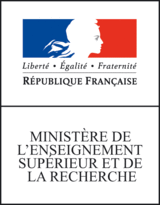GRS syntax
Global structure
A GRS is composed by a set of declarations that may be provided in several files.
These files are expected to used the .grs file extension.
Three kinds of declarations can be used:
- Rule declaration (keyword
rule) - Strategy declaration (keyword
strategy) - Package declaration (keyword
package)
Rules
Rule declaration is introduced by the keyword rule. For the syntax, see rule page.
Strategies
Strategies are used to specify the way rules are applied during transformation. The syntax of strategies definition is:
strat strat_id {
<<< strategy_description >>>
}
Strategy descriptions are defined by the following syntax:
S ::= rule_id % Apply the gives rule
| package_id % Apply any rule defined in the package (not in sub-packages)
| strat_id % Called a strategy defined elsewhere
| Pick (S) % Select arbitrary one of the graph produced by the strategy S
| Alt (S_1, …, S_n) % Collect graphs produced by each sub-strategies (union)
| Seq (S_1, …, S_n) % Apply sequentially S_1, then S_2 on S_1 output …
| Iter (S) % Iterate the application of the strategy S until normal forms
| If (S, S_1, S_2) % If S is productive then it is equivalent to S_1 else it is equivalent to S_2
Other constructors are provided for some strategies:
Empty ≜ Seq() % The Empty strategy always returns the input graph
Try (S) ≜ If (S, S, Empty) % Equivalent to S if S is productive else it returns the input graph
Computing one normal form
To compute only one normal form with a strategy S, one can used the strategy: Pick (Iter (S)):
the strategy Iter (S) computes the full set of normal forms and the Pick operator choses one of them.
But this may be not efficient as all the normal forms are computed before picking one of them (the number of normal forms can be high).
For this case, another implementation of the rewriting is available with the operator Onf (the name stands for ‘One normal form’).
With this operator, only one normal form is built, and so :
Onf (S) = Pick (Iter (S))
⚠️ But Onf can be safely used only if the strategy is terminating. More info about this on the rewriting page.
Packages
Packages are used to organize the set of declarations and to define scopes of definitions. Syntax of packages definition:
package package_id {
declarations_list
}
where declarations_list is a list of declarations of rules, packages and strategies.
The syntax for accessing to some element e defined in package P is P.e.
In case of nested packages, an identifier may look like P1.P2.P3.e.
When a reference is made to an element P1.P2.e, the system tries to find inside the current package a sub-package P1 which contains a sub-package P2 which contains an element e.
If no such element is found, the same thing is searched recursively, first in the mother package of the current one, up to the root package.
Multi-file management
When a GRS becomes large and contains an high number of rules, it is sensible to define it in several files. Two mechanisms are available for this purpose: external file import and external file inclusion.
External file import
At any place in a list of declaration in a GRS file, one can use the syntax:
import "filename.grs"
This creates a new package with the same name as the file (without the .grs extension).
Hence, the meaning of the code above is the same as the following code:
package filename {
<<< content of the file "filename.grs" >>>
}
External file inclusion
With file inclusion, the content of the external file is interpreted as if it was placed directly in the file at the same place. In other words, the code:
include "filename.grs"
has the same meaning as
<<< content of the file "filename.grs" >>>
A complete example
We consider the same GRS defined through the multi-file mechanism and with a single file.
Multi-file declaration
Consider a folder with the files:
-
rule r_1 { pattern { e:X -[L]-> Y} commands { del_edge e; add_edge X -[L_1]-> Y } } rule r_11 { pattern { e:X -[L_1]-> Y} commands { del_edge e; add_edge X -[L_11]-> Y } } rule r_12 { pattern { e:X -[L_1]-> Y} commands { del_edge e; add_edge X -[L_12]-> Y } } -
rule r_2 { pattern { e:X -[L]-> Y} commands { del_edge e; add_edge X -[L_2]-> Y } } rule r_21 { pattern { e:X -[L_2]-> Y} commands { del_edge e; add_edge X -[L_21]-> Y } } rule r_22 { pattern { e:X -[L_2]-> Y} commands { del_edge e; add_edge X -[L_22]-> Y } } -
import "p_1.grs" import "p_2.grs" strat p_1_nfs { Iter (p_1) } % all normal forms with package p_1 strat p_1_onf { Onf (p_1) } % one normal form with package p_1 strat union { Alt (p_1,p_2) } % union of the two set of rules strat all_nfs { Iter (union)} % all normal forms strat s_1 { Seq (Pick(p_1), Pick(p_2), all_nfs) }
Single file declaration
The five files above define a GRS, equivalent to the one below:
single.grspackage p_1 { rule r_1 { pattern { e:X -[L]-> Y } commands { del_edge e; add_edge X -[L_1]-> Y } } rule r_11 { pattern { e:X -[L_1]-> Y } commands { del_edge e; add_edge X -[L_11]-> Y } } rule r_12 { pattern { e:X -[L_1]-> Y } commands { del_edge e; add_edge X -[L_12]-> Y } } } package p_2 { rule r_2 { pattern { e:X -[L]-> Y } commands { del_edge e; add_edge X -[L_2]-> Y } } rule r_21 { pattern { e:X -[L_2]-> Y } commands { del_edge e; add_edge X -[L_21]-> Y } } rule r_22 { pattern { e:X -[L_2]-> Y } commands { del_edge e; add_edge X -[L_22]-> Y } } } strat p_1_nfs { Iter (p_1) } % all normal forms with package p_1 strat p_1_onf { Onf (p_1) } % one normal form with package p_1 strat union { Alt (p_1,p_2) } % union of the two set of rules strat all_nfs { Iter (union)} % all normal forms strat s_1 { Seq (Pick(p_1), Pick(p_2), all_nfs) }
Note that all the rules consist in the changement of the label of one edge.
Package p_1 rewrites the label L into L_1 and L_1 into either L_11 or L_12.
Similarly, package p_2 rewrites the label L into L_2 and L_2 into either L_21 or L_22.
Apply the GRS to a graph
Consider small graph with 3 nodes and 2 edges labeled L defined in
{
"nodes": { "0": "C", "1": "B", "2": "A" },
"edges": [
{ "src": "2", "label": "L", "tar": "1" },
{ "src": "1", "label": "L", "tar": "0" }
]
}
Next commands rewrite the graph input.json, following different strategies (⚠️ the -json option is needed to output graph in the JSON format instead of CoNLL-U).
strategy p_1_nfs
grew transform -grs single.grs -config basic -strat p_1_nfs -i input.json -json computes all normal forms for the input graph with rules of package p_1.
Each initial edges L can be rewritten either L_11 or L_12, and so 4 graphs are produced:
[
{
"meta": { "sent_id": "__0" },
"nodes": { "0": "C", "1": "B", "2": "A" },
"edges": [
{ "src": "2", "label": "L_11", "tar": "1" },
{ "src": "1", "label": "L_11", "tar": "0" }
]
},
{
"meta": { "sent_id": "__1" },
"nodes": { "0": "C", "1": "B", "2": "A" },
"edges": [
{ "src": "2", "label": "L_12", "tar": "1" },
{ "src": "1", "label": "L_11", "tar": "0" }
]
},
{
"meta": { "sent_id": "__2" },
"nodes": { "0": "C", "1": "B", "2": "A" },
"edges": [
{ "src": "2", "label": "L_11", "tar": "1" },
{ "src": "1", "label": "L_12", "tar": "0" }
]
},
{
"meta": { "sent_id": "__3" },
"nodes": { "0": "C", "1": "B", "2": "A" },
"edges": [
{ "src": "2", "label": "L_12", "tar": "1" },
{ "src": "1", "label": "L_12", "tar": "0" }
]
}
]
strategy p_1_onf
grew transform -grs single.grs -config basic -strat p_1_onf -i input.json -json produces one of the 4 graphs of the previous strategy.
{
"nodes": { "0": "C", "1": "B", "2": "A" },
"edges": [
{ "src": "2", "label": "L_12", "tar": "1" },
{ "src": "1", "label": "L_12", "tar": "0" }
]
}
strategy union
grew transform -grs single.grs -config basic -strat union -i input.json -json compute the application of the union of one step of rewriting with p_1 (which produces 2 graphs, replacing one the two L edge by L_1 and the same with p_2. In the end, 4 graphs are produced (there is no iteration of rule application).
[
{
"meta": { "sent_id": "__0" },
"nodes": { "0": "C", "1": "B", "2": "A" },
"edges": [
{ "src": "2", "label": "L", "tar": "1" },
{ "src": "1", "label": "L_1", "tar": "0" }
]
},
{
"meta": { "sent_id": "__1" },
"nodes": { "0": "C", "1": "B", "2": "A" },
"edges": [
{ "src": "2", "label": "L", "tar": "1" },
{ "src": "1", "label": "L_2", "tar": "0" }
]
},
{
"meta": { "sent_id": "__2" },
"nodes": { "0": "C", "1": "B", "2": "A" },
"edges": [
{ "src": "2", "label": "L_1", "tar": "1" },
{ "src": "1", "label": "L", "tar": "0" }
]
},
{
"meta": { "sent_id": "__3" },
"nodes": { "0": "C", "1": "B", "2": "A" },
"edges": [
{ "src": "2", "label": "L_2", "tar": "1" },
{ "src": "1", "label": "L", "tar": "0" }
]
}
]
strategy all_nfs
grew transform -grs single.grs -config basic -strat all_nfs -i input.json -json computes all normal forms that can be obtained with these all the rules and produces 16 graphs.
[
{
"meta": { "sent_id": "__0" },
"nodes": { "0": "C", "1": "B", "2": "A" },
"edges": [
{ "src": "2", "label": "L_11", "tar": "1" },
{ "src": "1", "label": "L_11", "tar": "0" }
]
},
{
"meta": { "sent_id": "__1" },
"nodes": { "0": "C", "1": "B", "2": "A" },
"edges": [
{ "src": "2", "label": "L_12", "tar": "1" },
{ "src": "1", "label": "L_11", "tar": "0" }
]
},
{
"meta": { "sent_id": "__2" },
"nodes": { "0": "C", "1": "B", "2": "A" },
"edges": [
{ "src": "2", "label": "L_21", "tar": "1" },
{ "src": "1", "label": "L_11", "tar": "0" }
]
},
{
"meta": { "sent_id": "__3" },
"nodes": { "0": "C", "1": "B", "2": "A" },
"edges": [
{ "src": "2", "label": "L_22", "tar": "1" },
{ "src": "1", "label": "L_11", "tar": "0" }
]
},
{
"meta": { "sent_id": "__4" },
"nodes": { "0": "C", "1": "B", "2": "A" },
"edges": [
{ "src": "2", "label": "L_11", "tar": "1" },
{ "src": "1", "label": "L_12", "tar": "0" }
]
},
{
"meta": { "sent_id": "__5" },
"nodes": { "0": "C", "1": "B", "2": "A" },
"edges": [
{ "src": "2", "label": "L_12", "tar": "1" },
{ "src": "1", "label": "L_12", "tar": "0" }
]
},
{
"meta": { "sent_id": "__6" },
"nodes": { "0": "C", "1": "B", "2": "A" },
"edges": [
{ "src": "2", "label": "L_21", "tar": "1" },
{ "src": "1", "label": "L_12", "tar": "0" }
]
},
{
"meta": { "sent_id": "__7" },
"nodes": { "0": "C", "1": "B", "2": "A" },
"edges": [
{ "src": "2", "label": "L_22", "tar": "1" },
{ "src": "1", "label": "L_12", "tar": "0" }
]
},
{
"meta": { "sent_id": "__8" },
"nodes": { "0": "C", "1": "B", "2": "A" },
"edges": [
{ "src": "2", "label": "L_11", "tar": "1" },
{ "src": "1", "label": "L_21", "tar": "0" }
]
},
{
"meta": { "sent_id": "__9" },
"nodes": { "0": "C", "1": "B", "2": "A" },
"edges": [
{ "src": "2", "label": "L_12", "tar": "1" },
{ "src": "1", "label": "L_21", "tar": "0" }
]
},
{
"meta": { "sent_id": "__10" },
"nodes": { "0": "C", "1": "B", "2": "A" },
"edges": [
{ "src": "2", "label": "L_21", "tar": "1" },
{ "src": "1", "label": "L_21", "tar": "0" }
]
},
{
"meta": { "sent_id": "__11" },
"nodes": { "0": "C", "1": "B", "2": "A" },
"edges": [
{ "src": "2", "label": "L_22", "tar": "1" },
{ "src": "1", "label": "L_21", "tar": "0" }
]
},
{
"meta": { "sent_id": "__12" },
"nodes": { "0": "C", "1": "B", "2": "A" },
"edges": [
{ "src": "2", "label": "L_11", "tar": "1" },
{ "src": "1", "label": "L_22", "tar": "0" }
]
},
{
"meta": { "sent_id": "__13" },
"nodes": { "0": "C", "1": "B", "2": "A" },
"edges": [
{ "src": "2", "label": "L_12", "tar": "1" },
{ "src": "1", "label": "L_22", "tar": "0" }
]
},
{
"meta": { "sent_id": "__14" },
"nodes": { "0": "C", "1": "B", "2": "A" },
"edges": [
{ "src": "2", "label": "L_21", "tar": "1" },
{ "src": "1", "label": "L_22", "tar": "0" }
]
},
{
"meta": { "sent_id": "__15" },
"nodes": { "0": "C", "1": "B", "2": "A" },
"edges": [
{ "src": "2", "label": "L_22", "tar": "1" },
{ "src": "1", "label": "L_22", "tar": "0" }
]
}
]




